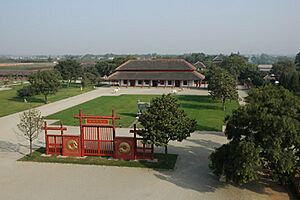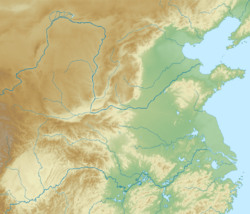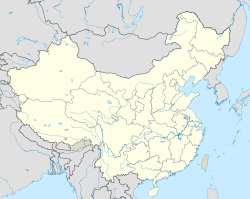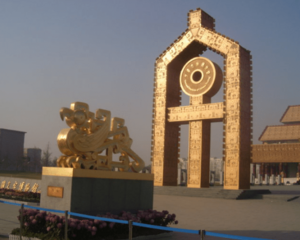Anyang facts for kids
Quick facts for kids
Anyang
安阳市
|
|
|---|---|
|
Prefecture-level city
|
|

|
|

Location of Anyang City jurisdiction in Henan
|
|
| Country | People's Republic of China |
| Province | Henan |
| Municipal seat | Wenfeng District |
| Area | |
| • Prefecture-level city | 7,355 km2 (2,840 sq mi) |
| • Urban | 543.5 km2 (209.8 sq mi) |
| • Metro | 2,392 km2 (924 sq mi) |
| Elevation | 69 m (226 ft) |
| Population | |
| • Prefecture-level city | 5,477,614 |
| • Density | 744.75/km2 (1,928.89/sq mi) |
| • Urban | 1,398,887 |
| • Urban density | 2,573.85/km2 (6,666.2/sq mi) |
| • Metro | 2,675,523 |
| • Metro density | 1,118.53/km2 (2,897.0/sq mi) |
| GDP | |
| • Prefecture-level city | CN¥ 203.0 billion US$ 30.6 billion |
| • Per capita | CN¥ 39,603 US$ 5,962 |
| Time zone | UTC+8 (China Standard) |
| Postal Code |
455000,456100,456300,456400,456500
|
| Area code(s) | 0372 |
| ISO 3166 code | CN-HA-05 |
| Major Nationalities | Han |
| County-level divisions | 9 |
| License plate prefixes | 豫E |
Anyang (simplified Chinese: 安阳; traditional Chinese: 安陽) is a big city in Henan province, China. It is the northernmost city in Henan. Anyang is next to Puyang in the east and Hebi and Xinxiang in the south. To its west and north are the provinces of Shanxi and Hebei.
In 2020, Anyang had over 5.4 million people. About 2.6 million of them lived in the main city area. Anyang is famous for being the site of Yinxu, an ancient city. Yin was the capital of the Shang dynasty and the first stable capital of China.
Contents
History of Anyang
Early History of Anyang

Long ago, during the Stone Age, prehistoric cavemen lived in Xiaonanhai. This area is on the western edge of Anyang. Over 7,000 old tools and animal bones have been found here. These finds show a culture called the Xiaonanhai culture.
Around 2000 BC, two legendary kings, Zhuanxu and Emperor Ku, are said to have built their capitals near Anyang. They ruled their kingdoms from here. Today, you can find their tombs in Sanyang village.
In the early 14th century BC, King Pangeng of the Shang dynasty built his capital. It was about 2 kilometers north of modern Anyang, by the Huan River. This city was called Yin. It was the first stable capital in Chinese history. After this, the Shang dynasty was also known as the Yin dynasty.
Twelve kings ruled from Yin over eight generations. One famous king was Wu Ding. Under his rule, the Shang dynasty became very powerful. The capital was used until 1046 BC. This was when King Wu of Zhou and the Zhou took over.
Anyang became the main town of Anyang County around 607 CE. It has been an important center ever since. In Anyang's Tangyin County, there was a village called Yue. This was the birthplace of Yue Fei, a famous general from the Song dynasty.
Modern Anyang History
Until 1912, the town was known as Zhangde. Then, when the Republic of China was formed, it was renamed Anyang.
In August 1949, Anyang was moved from Henan province. It joined Puyang and Xinxiang in a new, short-lived province called Pingyuan. This was done by the ruling Communist government. But in November 1953, Pingyuan province was dissolved. All three cities, including Anyang, returned to Henan.
Geography and Climate
Anyang's Landscape
Anyang covers a total area of about 7,355 square kilometers. The land in Anyang is generally higher in the west. This is where the foothills of the Taihang Mountains are located. The eastern part of the city is lower. It is part of the North China Plain.
Anyang's Weather
Anyang has a climate with four distinct seasons. It is influenced by monsoons. Winters are cold and very dry. The average temperature in January is about -0.8°C (30.6°F). Summers are hot and humid. July's average temperature is around 27.2°C (81.0°F).
Most of the yearly rainfall, about 552 millimeters (21.7 inches), happens in July and August. The average temperature for the whole year is about 14.28°C (57.7°F). Anyang gets about 2,225 hours of sunshine each year. The sunniest time is from April to June. The highest temperature ever recorded was 43.2°C (109.8°F). The lowest was -21.7°C (-7.1°F).
| Climate data for Anyang (1991–2013 normals) | |||||||||||||
|---|---|---|---|---|---|---|---|---|---|---|---|---|---|
| Month | Jan | Feb | Mar | Apr | May | Jun | Jul | Aug | Sep | Oct | Nov | Dec | Year |
| Record high °C (°F) | 20.7 (69.3) |
27.2 (81.0) |
31.3 (88.3) |
37.0 (98.6) |
39.5 (103.1) |
43.2 (109.8) |
41.8 (107.2) |
39.5 (103.1) |
39.3 (102.7) |
34.6 (94.3) |
27.7 (81.9) |
26.3 (79.3) |
43.2 (109.8) |
| Mean daily maximum °C (°F) | 4.2 (39.6) |
8.8 (47.8) |
14.4 (57.9) |
21.4 (70.5) |
26.9 (80.4) |
32.3 (90.1) |
32.0 (89.6) |
30.4 (86.7) |
26.9 (80.4) |
21.5 (70.7) |
12.9 (55.2) |
6.0 (42.8) |
19.8 (67.6) |
| Daily mean °C (°F) | −1.2 (29.8) |
3.0 (37.4) |
8.5 (47.3) |
15.4 (59.7) |
21.1 (70.0) |
26.2 (79.2) |
27.3 (81.1) |
25.7 (78.3) |
21.2 (70.2) |
15.2 (59.4) |
7.0 (44.6) |
0.7 (33.3) |
14.2 (57.5) |
| Mean daily minimum °C (°F) | −5.3 (22.5) |
−1.7 (28.9) |
3.3 (37.9) |
9.7 (49.5) |
15.4 (59.7) |
20.4 (68.7) |
23.1 (73.6) |
21.9 (71.4) |
16.6 (61.9) |
10.2 (50.4) |
2.4 (36.3) |
−3.3 (26.1) |
9.4 (48.9) |
| Record low °C (°F) | −21.7 (−7.1) |
−16.7 (1.9) |
−10.1 (13.8) |
−2.7 (27.1) |
5.5 (41.9) |
10.2 (50.4) |
15.8 (60.4) |
11.6 (52.9) |
5.5 (41.9) |
−1.4 (29.5) |
−11.4 (11.5) |
−18.1 (−0.6) |
−21.7 (−7.1) |
| Average precipitation mm (inches) | 5.2 (0.20) |
8.8 (0.35) |
15.4 (0.61) |
26.0 (1.02) |
40.2 (1.58) |
59.9 (2.36) |
162.2 (6.39) |
118.5 (4.67) |
59.9 (2.36) |
27.2 (1.07) |
18.9 (0.74) |
5.6 (0.22) |
547.8 (21.57) |
| Average precipitation days (≥ 0.1 mm) | 3.0 | 3.3 | 3.7 | 4.9 | 6.7 | 7.7 | 11.2 | 8.9 | 7.6 | 5.3 | 4.1 | 2.7 | 69.1 |
| Average snowy days | 3.4 | 3.2 | 1.5 | 0.3 | 0 | 0 | 0 | 0 | 0 | 0 | 1.5 | 2.9 | 12.8 |
| Average relative humidity (%) | 61 | 58 | 57 | 60 | 64 | 61 | 77 | 80 | 74 | 67 | 67 | 65 | 66 |
| Mean monthly sunshine hours | 111.0 | 130.4 | 174.9 | 207.7 | 227.8 | 204.7 | 168.9 | 174.8 | 157.8 | 156.0 | 133.9 | 113.1 | 1,961 |
| Percent possible sunshine | 36 | 42 | 47 | 53 | 52 | 47 | 38 | 42 | 43 | 45 | 44 | 38 | 44 |
| Source: China Meteorological Administration | |||||||||||||
How Anyang is Governed
Divisions of Anyang City
The city of Anyang is divided into different parts for easier management. It has 4 districts, 1 county-level city, and 4 counties. These bigger areas are then split into smaller ones. There are 46 subdistricts, 66 towns, and 23 townships. These smaller areas manage 302 residential communities and 2,979 villages.
Here are the main divisions of Anyang:
- Beiguan District
- Wenfeng District
- Yindu District
- Long'an District
- Linzhou City
- Anyang County
- Tangyin County
- Hua County
- Neihuang County
| Map |
|---|

Wenfeng
Beiguan
Yindu
Long'an
Anyang
County Tangyin
County Hua
County Neihuang
County Linzhou
(city) |
People of Anyang
Population and Ethnic Groups
According to the 2020 Chinese Census, Anyang has a population of about 5.48 million people. Most of the people in Anyang are Han Chinese. There are also about 10,000 people from other ethnic groups.
Anyang is home to 43 different ethnic minorities. Some of the larger groups include the Hui, Mongols, Manchus, and Zhuang.
Anyang's Economy
Main Industries and Resources
Anyang is mostly an industrial city. Its main industries include making metals like iron and steel. They also produce coal coke and clothing. A big Chinese steel company, Shagang Group, has factories in Anyang.
The city has many important mineral resources. These include dolomite, potassium-rich shale, nepheline syenite, quartzite, limestone, and clay.
Economic Growth and Income
In 2021, the total value of goods and services produced in Anyang, called its gross domestic product (GDP), was 243.55 billion renminbi (RMB). This was a 5% increase from the year before. Farming and raw materials made up 9.7% of the GDP. Manufacturing and construction made up 43.7%. Services like shops and tourism made up 46.6%.
The money people had to spend, called disposable income, was 27,365 RMB per person in 2021. This was a 7.2% increase from 2020. People living in the city had a disposable income of 37,464 RMB. People in rural areas had 18,424 RMB.
Anyang has also welcomed foreign businesses. Sixteen foreign-funded companies have started operations here. The city has a special economic zone to attract more businesses. This zone is about 22.8 square kilometers. The Anyang Hongqiqu Airport also opened on November 29, 2023.
Tourism in Anyang
Ancient City and Cultural Sites
Anyang is a very old city, with a history of over 3,000 years. It is one of the Eight Ancient Capitals of China. It is also one of the best-preserved ancient cities. Anyang is a key place where ancient Chinese culture began.
Here you can find very old caves from 25,000 years ago. There are also layers of different ancient cultures like the Yangshao Culture. You can visit the tombs of ancient Emperors Zhuanxu and Emperor Ku. These tombs are over 4,000 years old.
Anyang has the first library of inscriptions on bones and tortoise shells. These are ancient writings on animal bones and turtle shells. You can also visit the Soul Spring Temple. It is known as the "First Ancient Buddhist Temple in Henan." There is also the 10,000-Buddha Ravine.
The city has three large museums. These are the Anyang Museum, the National Museum of Chinese Writing, and the Yinxu Museum. The Yinxu Museum is located at the ruins and royal tombs of the Shang dynasty.
Natural Beauty in Anyang
Anyang also has beautiful natural scenery. You can explore the Taihang Linlu Hill Scenic Area. This area is part of the 400-kilometer Taihang Mountains. There is also the grand 1,500-kilometer Red Flag Canal.
Changchun Temple
Changchun Temple is a Taoist temple. It was built on the side of the mountains during the Tang dynasty. After careful restoration, it opened to the public on May 1, 2014.
Tianning Temple
Tianning Si, also known as Mansion Temple, was built during the Zhou dynasty. It has been restored and is now open to visitors. Inside the temple, you can see the gate house. There is also the Hall of the Heavenly King, rebuilt in 2002. The larger Precious Hall of the Great Hero was rebuilt in 2001. The famous Wenfeng Pagoda is also on its grounds.
Wenfeng Pagoda
Wenfeng Ta, or Literature Peak Pagoda, is located at the Tianning Temple. It is thought to have been built in 925. Records show it was definitely there by 952. The current pagoda was built during the Ming dynasty. It got its name during the Qing dynasty because it was near a Confucian temple.
This five-story pagoda is made of dark red bricks. It is 38.65 meters (126.8 feet) high. What's special about it is that it's wider at the top than at the bottom! It has a 10-meter (32.8 feet) Lamaist stupa-style top. The pagoda stands on a 2-meter (6.6 feet) stone base. It is decorated with carvings of Buddhas and other figures. This unique pagoda is a symbol of Anyang.
Yinxu Ruins and Museum
About 2 kilometers (1.2 miles) northwest of Anyang are the ruins of Yin. This was the capital of the Shang dynasty. This huge archaeological site was found in 1899. It was excavated over many years. It first opened to the public in the 1980s as the Garden Museum of Yinxu.
The current Yinxu museum opened on March 16, 2005. It includes the famous Tomb of Fu Hao. In 2006, the site was named a UNESCO World Heritage Sites. This means it is a very important place for everyone in the world.
See Also
 In Spanish: Anyang para niños
In Spanish: Anyang para niños
- List of twin towns and sister cities in China
- Historical capitals of China
- History of the political divisions of China






